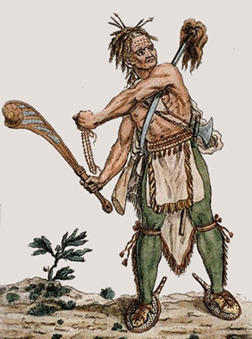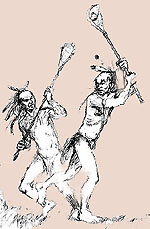 |
Iroquois Man
![]()
The life
cycle of the Iroquois Man was dominated by the seasons. In the fall and through
Mid Winter, Iroquois hunters left their Longhouses
to hunt. Their most important prey were deer; hunters needed to kill at least
one a week to feed their families. In the spring the men fished, though farming
provided for most of the Iroquois diet. Corn, beans and squash,
"The Three Sisters" provided sustenance for Iroquois families.
While the women of the tribe owned and tended the fields, it was the men's
responsibility to clear and prepare the land for planting.
When not involved in hunting or soil preparation the life of the Iroquois
male was filled with preparation for warfare. This preparation even spilled
over into their leisure activities, which included such physically demanding
activities as  Lacrosse
Lacrosse
After marriage, a man moved into his wife's longhouse, and their children became members of her clan. Iroquois villages were generally fortified and large. The distinctive, communal longhouses of the different clans could be over 200' in length and were built about a framework covered with elm bark, the Iroquois' material of choice for all manner of things. Villages were permanent in the sense they were moved only for defensive purposes or when the soil became exhausted (about every twenty years).
Iroquois warriors wore their hair in a distinctive scalplock (Mohawk of course), although other styles became common later. While the men carefully removed all facial and body hair, women wore theirs long. Tattoos were common for both sexes.
Iroquois spiritual life was very rich. The False Face society is an example of an Iroquois spiritual association, which utilized grotesque wooden masks to frighten the evil spirits believed to cause illness. These wooden masks are highly sought after by collectors and non-Iroquois, but because they serve a spiritual purpose they are not intended for sale and are protected by Iroquois tribal law. For a better understanding of how contemporary Iroquois feel about False Face Society Masks, follow this link.
The European desire for furs, especially beaver, began to dominate an Iroquois man's life in the seventeenth and eighteenth centuries. In exchange for furs, Iroquois men brought home a wealth of useful trade goods, especially metal items such as guns, axes, knives, hoes, cooking pots, needles, scissors, and nails. By 1800, the Iroquois had exhausted their own supply of beaver.
Through
alliances, first with the Dutch and then with the English, the Iroquois established
themselves as the middlemen in the fur trade. They regulated the flow of furs
coming from the western tribes to the traders in the east. As the supply of
fur bearing animal dwindled and eventually dried up, so did the Iroquois'
dominant role in the fur trade.
Home Page | Assessment
| Lesson 1 | Lesson
2 | Lesson 3 | Lesson
4 | Frontier
Characters
Learning Aids | Great
Law of Peace | US Constitution | Timeline
| Works Cited
© 1 October 2001, Portland State University